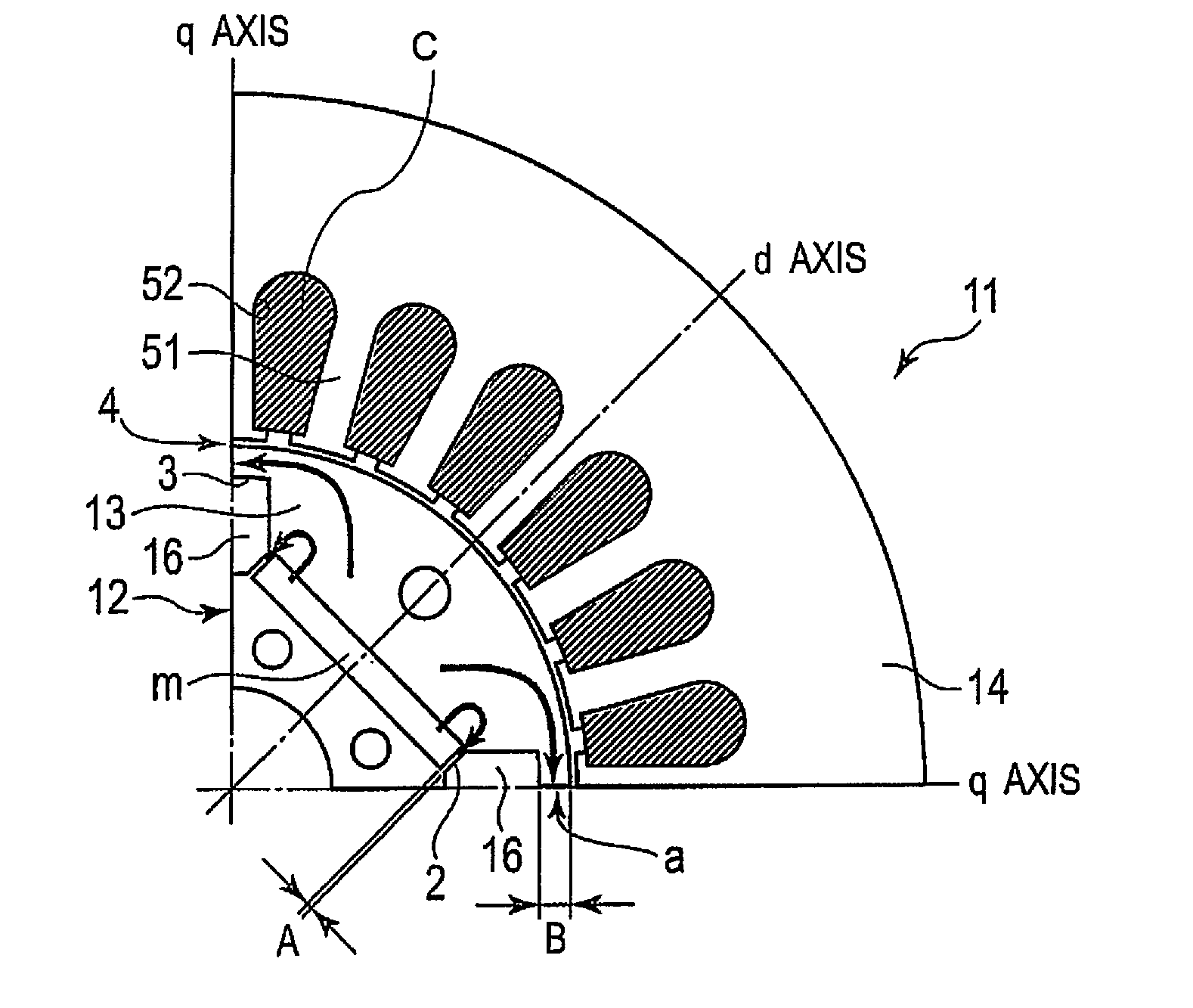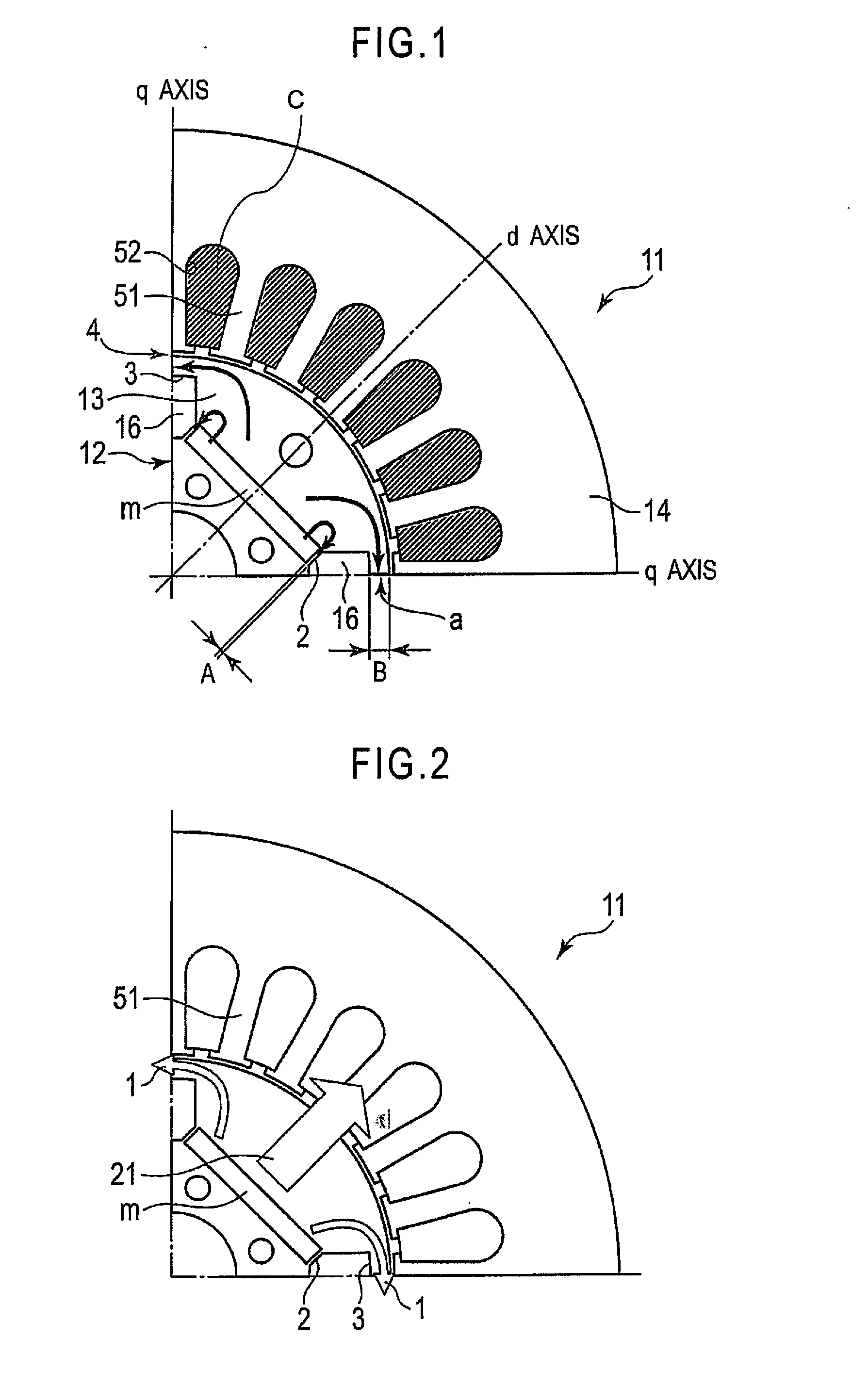Variable magnetic flux-type rotary electric machine
a rotary electric machine and magnetic flux technology, applied in the direction of dynamo-electric machines, magnetic circuit rotating parts, magnetic circuit shape/form/construction, etc., can solve the problems of high energy loss, design and use restrictions, etc., to inhibit the amount of magnetic flux leakage, and generate maximum torque
- Summary
- Abstract
- Description
- Claims
- Application Information
AI Technical Summary
Benefits of technology
Problems solved by technology
Method used
Image
Examples
first embodiment
[0025]FIG. 1 is a diagram showing the configuration of a rotary electric machine pertaining to a first embodiment. A portion that constitutes one-fourth of the entire configuration is shown. Each other one-fourth of the remaining three-fourth of the entire configuration of the rotary electric machine repeats the illustrated one-quarter in a continuous repeating manner. As shown in FIG. 1, this rotary electric machine has a stator 11 that is formed in the shape of a ring, and a rotor 12 that is formed in the shape of a circle that is concentric with the stator 11 to form an electric motor or generator.
[0026]The stator 11 has a stator core 14 and a plurality of (e.g., 24) teeth 51 that protrude inwards from the stator core 14. The spaces between adjacent teeth 51 are regarded as slots 52. A stator coil C is wound on the teeth 51. The stator core 14 is formed, for example, from laminated iron sheets.
[0027]The rotor 12 has a rotor core 13, where the rotor core 13 is formed in the shape ...
second embodiment
[0060]A second embodiment is described below. FIG. 9 is a diagram showing the configuration of the rotary electric machine of the second embodiment. In FIG. 9, only one-fourth of the entire rotary electric machine is shown. Each other one-fourth of the remaining three-fourth of the entire configuration of the rotary electric machine repeats the illustrated one-quarter in a continuous repeating manner. For the sake of simplicity, the same reference numbers of the first embodiment will be used to describe the second embodiment. As shown in FIG. 9, as with the first embodiment described above, the rotary electric machine of the second embodiment has the annular stator 11 and the rotor 12 concentrically arranged with the air gap 4 serving as a gap portion between the stator 11 and the rotor 12. The rotor 12 has a rotor core 13.
[0061]On the circumferential edge part of the stator core 13 opposite the stator 11, four permanent magnets m (specifically, a quadrupole structure) are provided ...
third embodiment
[0067]A third embodiment is described below. FIG. 11 is a diagram showing the configuration of the rotary electric machine according to a third embodiment. FIG. 11, as with the first and second embodiments, shows only one-fourth of the entire rotary electric machine. Each other one-fourth of the remaining three-fourth of the entire configuration of the rotary electric machine repeats the illustrated one-quarter in a continuous repeating manner. For the sake of simplicity, the same reference numbers of the first embodiment will be used to describe the third embodiment. As shown in FIG. 11, as with the first and second embodiments described above, the rotary electric machine of the second embodiment has the annular stator 11 and the rotor 12 concentrically arranged with the air gap 4 serving as a gap portion between the stator 11 and the rotor 12. The rotor 12 includes the rotor core 13.
[0068]On the circumferential edge part of the stator core 13 opposite the stator 11, four permanent...
PUM
 Login to View More
Login to View More Abstract
Description
Claims
Application Information
 Login to View More
Login to View More - R&D
- Intellectual Property
- Life Sciences
- Materials
- Tech Scout
- Unparalleled Data Quality
- Higher Quality Content
- 60% Fewer Hallucinations
Browse by: Latest US Patents, China's latest patents, Technical Efficacy Thesaurus, Application Domain, Technology Topic, Popular Technical Reports.
© 2025 PatSnap. All rights reserved.Legal|Privacy policy|Modern Slavery Act Transparency Statement|Sitemap|About US| Contact US: help@patsnap.com



